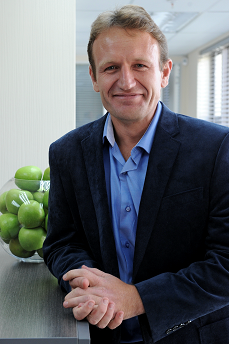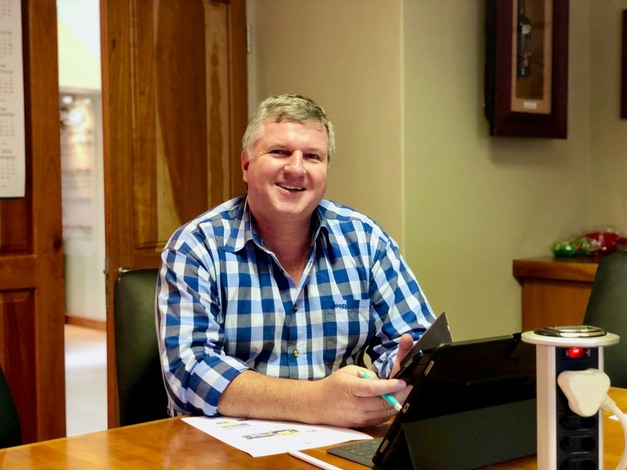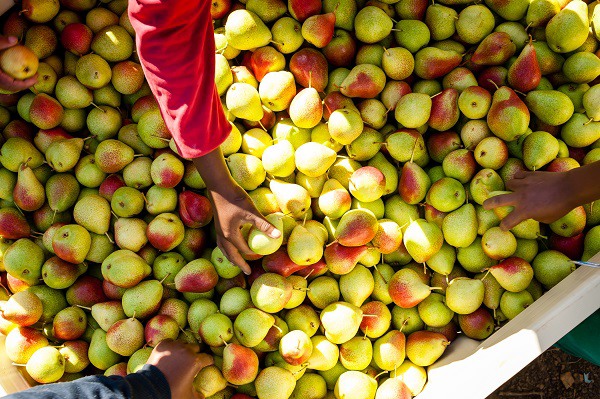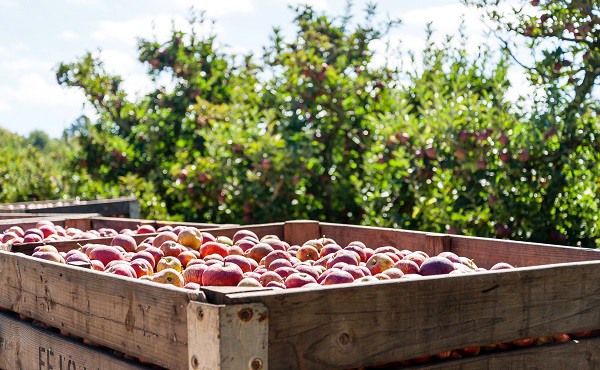 The “massive” impact of hail in Ceres and Grabouw was probably underestimated in the South African topfruit industry’s first crop estimate, according to topfruit producer and exporter Tru-Cape.
The “massive” impact of hail in Ceres and Grabouw was probably underestimated in the South African topfruit industry’s first crop estimate, according to topfruit producer and exporter Tru-Cape.
From what they’ve been seeing in their packhouses over February, Tru-Cape’s managing director Roelf Pienaar told journalists at a press briefing, they reckon that apple and pear export volumes could dip by 8% to 10%.
 Recent wind disruptions, which forced the port of Cape Town to cease loading for a number of days, resulted in some of their containers being left quayside when a shipping line decided to “cut and run”. Port operations have resumed and in toto, said Roelf (right), logistics are faring better than twelve months ago.
Recent wind disruptions, which forced the port of Cape Town to cease loading for a number of days, resulted in some of their containers being left quayside when a shipping line decided to “cut and run”. Port operations have resumed and in toto, said Roelf (right), logistics are faring better than twelve months ago.
The company prefers to ship in containers but the several conventional vessels on which they loaded last year made a “massive” difference.
Breakbulk isn’t something they’d consider for the Far East, but it makes sense for the UK, Europe and Russia.
Roelf told the media that the European market has been much more subdued and cautious than usual.
At Tru-Cape they have responded with stricter intake policies, explained Conrad Fick, Tru-Cape’s marketing director, and being more careful in terms of the size profile they are sending to Europe this season.
“Consumers are switching from managed varieties (or club varieties) to more run of the mill varieties which is,” Roelf remarked, “an indication of how difficult the market is.”
The floods in New Zealand could perhaps open up spaces for South Africa, but after the bullishness with which they started last season, they’re reticent to make predictions.
 Tru-Cape marketing director Conrad Fick
Tru-Cape marketing director Conrad Fick
Retail opportunities in China
Russia remains important to their marketing strategy. “You still need Russia to take certain varieties and certain grades. It’s important for pears, especially, but I’d say it’s equally uncertain as Europe and more subdued than two or three years ago.”
“With new plantings, at Tru-Cape we’re well-positioned to grab the Middle East, India, the Far East,” Roelf continued, which have a further advantage to Europe in that their populations are growing. Tru-Cape grows topfruit on over 7,000 ha.
Last year shipping costs kept Chile out of the Middle East, to South Africa’s benefit – it’ll be interesting to see whether that dynamic plays out again.
Malaysia is still a far bigger market for South African topfruit than China, but now that South African pears can be sent to China, Tru-Cape is excited about the retail opportunities that exist in China for Forelle pears.

"We’re looking forward to Thailand re-opening, from a South African prospect that would be exciting,” Roelf said, noting that South Africa would there be competing with New Zealand. The Philippines is another high-potential but as yet closed market.
Africa offers security which other Southern Hemisphere apple producers don’t have. When combined with the local market, easily half of South Africa’s apples go into Africa.
However, African trade is currently hampered by the redesign of the Nigerian Naira causing a shortage in new notes, while there’s a lack of CFA in West Africa. Meanwhile Ghana's inflation is 54.1%, Conrad mentioned.
"We're having interesting price discussions"
The South African Rand recently weakened significantly and South Africa’s greylisting by the Financial Action Task Force is a concern to those trading internationally.
“Shipping rates are a smidgen cheaper but in Rands we’re paying more for shipping if you look at the exchange rate. We’re having interesting price discussions with our clients,” Conrad remarked.

Power cuts are creating “havoc” on farms; Roelf told of a Tru-Cape grower who was paying R150,000 (7,700 euros) per month on diesel for generators to keep the cold chain intact.
Conrad added that the costs of running generators was coming straight from the bottom line. “That is the difference between survival and non-survival.”
Roelf pointed out that while producers were burdened by production costs rises in the order of 25% to 30% year-on-year, overseas retailers are seeing similarly rising costs and consumers – consumers in Europe in particular - can’t afford the rise in costs.
There would have to be some kind of price adjustment, he concluded.










